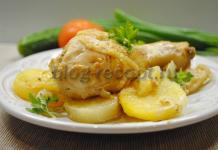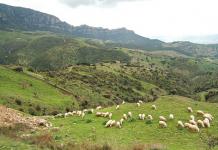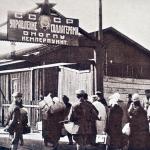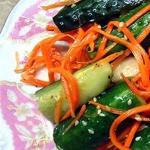In continuation of the series of articles about Italian hard cheeses, I am publishing a short review of Pecorino Romano - one of the members of the Pecorino family of cheeses, which are made from sheep's milk and aged for quite a long time. The name Pecorino is derived from pecora, which means "sheep" in Italian. The word Romano partly refers to the region where the cheese is made: Grosetto, Lazio (Rome and the surrounding area), and Sardinia.
You can read notes about other popular Italian hard cheeses (though made from cow's milk) here:,.
A little theory and history
The Pecorino family includes many different cheeses, but four are the most famous: Pecorino Romano, Pecorino Sardo, Pecorino Toscano, Pecorino Siciliano. For now, we are only interested in Pecorino Romano, which, it must be said, is close in production technology to Pecorino Sardo and Pecorino Siciliano (although it is distinguished by increased salinity). All four types of Pecorino are protected by geographical designation (PDO category), that is, they can only be produced within strictly defined areas. This ensures compliance with certain production and taste standards and helps maintain quality at a high level, although it has a negative impact on the final price of the cheeses.
Pecorino Romano is produced on the island of Sardinia (along with another local Pecorino - Sardo), in the provinces of Grosseto and the administrative region of Lazio, of which Rome is the capital. This cheese has been made in the vicinity of Rome for a very long time, dating back to the times of the Roman Empire. It is believed that this cheese was an important part of the diet of Roman legionaries; mentions of it are found in the works of Hippocrates and Pliny the Elder. In Sardinia, Pecorino Romano has been produced since the end of the 19th century.

Pecorino Romano matures for at least five months and is made with a significant amount of manual labor (in particular, it is “fermented” and salted by hand, and a lot of salt is put into it). The milk comes from sheep that graze on natural pastures in Sardinia and Lazio. Subsequently, the milk is subjected to short-term heat treatment (heating to 68 degrees for 15 minutes).
Then - at the right time - a strictly defined starter, an enzyme from lamb rennet (the lambs must again be raised either in Lazio or Sardinia), salt are added; then cylinder circles are formed, placed in molds and sent for ripening (of course, this is an extremely simplified description of the production process). One wheel of Pecorino Romano cheese weighs from 20 to 45 kilograms. The ripening period usually does not exceed 12 months.

I have already written about the Trentin company - unremarkable and not very well-known - in articles about and, so I will not repeat it.

The composition of Pecorino Romano cheese is as follows: sheep's milk (pasteurized), salt, rennet, lactic acid bacteria. Fat content - about 30%. The mass fraction of fat in dry matter is about 45%. Energy value - 390-420 kcal.

Personal impressions
The color of Pecorino Romano from Trentin is very light, almost white, but with a very slight yellowish-cream tint. The consistency is hard, granular, crumbling. The aroma is moderate, cheesy, salty, slightly spicy. The taste is rich, bright, slightly spicy, piquant, even harsh. The taste is very peculiar, I would say - not for everyone. Salinity is high. The aftertaste is salty, islandy, and very long. An interesting but specific cheese that not everyone will like.

Pecorino Romano can be eaten in its pure form, but it seems to me better to add it to hot dishes - for example, pasta, fish, and so on. And remember that you need to salt the dish itself very carefully, since the cheese itself has a high salt content. By the way, it is very likely that Pecorino Romano can be used to make excellent cheese chips that go well with beer: at least I have seen a recipe for parmesan chips.
Nuts, toast, unsweetened fruits, and dry wines are good accompaniments to Pecorino Romano.
Where to buy and how much it costs
Pecorino Romano cheese is not very often found in Russian stores, but for residents of large cities it is quite easy to find it. In particular, this cheese is sold in Auchan. The price of a 200-gram package of Pecorino Romano from Trentin is about 140 rubles, and if you buy it by weight, a kilogram of this cheese will cost you about 550-600 rubles. This is a low price; in regular supermarkets, prices for 200-gram packages of Pecorino Romano (not necessarily Trentin) start at about 200 rubles and sometimes reach 350 rubles.
The word pecora means sheep in Italian and means livestock in Latin.
First of all, we note that pecorino in Italian it is more correct to call "cacio", but not "formaggio", as most modern cheeses are called. It was the “cacho” that was first made by the mythological shepherd, the Cyclops Polyphemus. In the central and southern regions of modern Italy, the name of the product comes from the Latin caseus. The term "formaggio" (from the Latin formaticus) appeared much later, in the Middle Ages, its source is called the Po River Valley, explaining its origin by reference to the shape of the cheese head, similar to the shape of round bread.
From Tuscany and further south pecorino, without a doubt, the most common: moderately moist, moderately spicy - a constant companion of beans and pasta. Residents of the northern part of the country are accustomed to a varied variety of this sheep's cheese, which varies from the very hard mountain variety to the creamy lowland variety. This does not confuse at all, and even pleases local gourmets who are well versed in this diversity.
Each region has its own understanding of the correct pecorino, which depends on the conditions under which the sheep are kept, their diet, but most of all, on the traditions of making cheese. It is worth noting that almost throughout Italy, the shepherds of sheep flocks are immigrants from Sardinia, who nevertheless try to adopt the local manufacturing style pecorino, preventing the “sardination” of mainland varieties.
Pecorino rich in essential amino acids, vitamins A, B, PP, C, E, calcium and phosphorus, which makes this cheese a dietary product.
There are four main varieties pecorino, each of which is protected by a Certificate of Protected Designation of Origin (DOP), the status of which is confirmed by the laws of the European Union.
Pecorino Romano probably the most famous variety outside of Italy pecorino. Best known Pecorino Romano in the United States, which has been the most important export market for this cheese since the 19th century.
Largest quantity Pecorino Romano produced on the island of Sardinia, although its production is also allowed in the Lazio region and in the Tuscan province of Grosseto.
Aged varieties pecorino, produced and distributed from Genoa and Liguria, also made from Sardinian pecorino.
Other varieties Pecorino DOP are Pecorino Sardo from Sardinia; Pecorino Toscano , Tuscan relative Pecorino Sardo(which is also made exclusively by Sardinians who emigrated to Southern Tuscany with their herds in the 1950s), and Pecorino Siciliano (or in Sicilian Picurinu Siciliana) from Sicily.
Also cheeses Pecorino are separated depending on exposure. The ripest, most seasoned cheese is called stagionato, having a hard, but grainy-crumbly, oily consistency and a nutty flavor. Two other types" semi-stagionato" (semi-aged) and " fresco" (young) have a softer consistency and a creamy milky taste.
In the South, there is a tradition of adding black pepper or red chili pepper flakes to pecorino. Nowadays, many other additives have begun to be used in production. pecorino, for example, walnuts, arugula or pieces of white and black truffle.
In Sardinia, in Pecorino Sardo The larvae of cheese flies are specially introduced to produce a local delicacy called Casu marzu, which translates from Sardinian as “rotten cheese.”
Good aged Pecorino (stagionato) often ends meals. It is usually served alongside pear and walnuts or drizzled with tart chestnut honey.
Pecorino often consumed after pasta dishes, and is also used as an alternative to the more expensive Parmesan in most regions of Italy from Umbria to Sicily. And in some pasta dishes typical of Rome and all of Lazio Pecorino is more preferred, for example Pasta with sauce "all"amatriciana", pasta with cheese and pepper, and pasta "alla Gricia".
Young pecorino combined with tomatoes and basil makes a great appetizer. A classic Tuscan dish is Pecorino with green beans (Pecorino con i baccelli). For dessert you can offer pecorino with fruits, wild berries, marmalade. Unexpected and very tasty dessert pecorino with honey (Pecorino al miele). Baking is popular in Sardinia pecorino - Casadinas.
White wines are more suitable for young cheese: Bianco di Pitigliano, Monteregio, Montecucco Bianco, Dolcetto d'Alba, Refosco, Vernaccia di San Gimignano.
Durum varieties pecorino often served after meals. Red wines go well with this cheese: Chianti Classico, Barolo, Morellino di Scansano, and on special occasions - Brunello di Montalcino.
Hard cheeses pecorino added in grated form to ribollita, different types of pasta (for example, cannelloni, cannelloni with milk lamb ragout), meat dishes (stuffed beef, pork rolls), pizza (for example, Apulian).
A little more about Pecorino Romano
Pecorino Romano - hard, salty italian cheese, made from sheep's milk (the Italian word Pecora translates to "sheep"), is suitable mainly for grating.
Pecorino Romano- the most famous of all varieties pecorino and an important part of Roman cuisine. A wheel of cheese reaches a mass of 33 kilograms, and the product is used mainly in grated form as one of the ingredients of various dishes. Unfortunately, only 10% of what is produced today Pecorino Romano can be called traditional cheese, the vast majority is made from pasteurized or thermized milk, which is allowed by Italian law.
In production Pecorino Romano curdled milk is heated to 45 °C, and after a day it is freed from whey and pressed. After 90 days of ripening, the product becomes quite dry and salty. After this, the cheese wheels are placed in chambers with low temperature and high humidity, where they reach an age of 10-12 months or even more. Sometimes they are covered with film. matured Pecorino Romano It has a salty spicy taste, a whitish tint and a consistency that makes it easy to grate cheese.
Pecorino Romano for many centuries they were produced on the outskirts of Rome, in Lazio. But in 1884, the city council of Rome banned the salting of cheese directly in stores, and because of this, many producers moved to the island of Sardinia.
Pecorino Romano produced exclusively from the milk of sheep raised in the plains of Lazio and Sardinia. His produced between November and the end of June, when sheep are free to graze on natural pastures. The largest cheese production is now located on the island of Sardinia, especially in the commune of Gavoi.
Pecorino Romano was one of the main products in the diet of legionnaires of Ancient Rome, who took this cheese with them on campaigns. Today it is still produced according to the original recipe and is one of the oldest cheeses in Italy.
Pecorino Romano most often used for sprinkling pasta dishes, like the famous Parmigiano Reggiano (parmesan). An incomparably aromatic, pleasantly spicy and salty taste is very characteristic of Italian cuisine. Exactly Pecorino Romano, most preferred for some pasta dishes with tasty sauces that are of Roman origin, such as bucatini all'amatriciana.
The sharpness of the cheese depends on its ripening period, which varies from five months for cheeses that are served as a snack and up to twelve months for cheese that is grated. During this time, its characteristic taste and aroma develop.
Pecorino Romano salty, with a fruity flavor, the cheese becomes more and more spicy over time. The color of the cheese rind depends on its degree of maturity; it may be covered with a protective coating of lard or vegetable oil. The color of the cheese is white or pale yellow, with uneven, small holes. The same cheese made outside the Lazio region is called Pecorino tipo Romano.
Pecorino Romano should not be confused with Pecorino Toscano(from Tuscany) or Pecorino Sardo(from Sardinia). Unlike Pecorino Romano, these cheeses (which are not particularly salty) are typically eaten as an appetizer or on sandwiches.
Cheese production method Pecorino Romano was first described by the ancient Roman authors Varro and Pliny the Elder about 2000 years ago. This cheese was first made in the countryside near Rome. Nowadays Pecorino Romano especially popular in Central and Southern Italy.
On the first of May, Roman families traditionally eat Pecorino with fresh beans during a day tour of Roman Campania.
Pecorino Romano- cheese that is used traditionally New Haven pizza, also known as " apizza". (New Haven pizza is a type of Neapolitan pizza that is very common in New Haven, Connecticut).
A little more about Pecorino Sardo
Pecorino Sardo , also known as Sardinian flower, is a hard cheese from the Italian island of Sardinia.
Pecorino Sardo made from the milk of Sardinian sheep raised specifically in Sardinia, which are fed only with local herbs.
In 1991 Pecorino Sardo was awarded DOP (Denominazione d'Origine Protteta) status, and in 1996 the European Union confirmed a protected designation of origin for this cheese.
There are currently several different recipes pecorino sardo, but almost all of them have been changed and corrected by modern recommendations and, unfortunately, imply thermization of milk. Unlike previous varieties, this cheese is immediately placed in a warm room after being placed in molds, and is sent to brine only the next day. The ripening period ranges from 8 to 12 months, but can be extended at the request of the manufacturer. The height of the cheese head is 10-15 cm, and its weight is about 3 kilograms. The crust has a brownish tint, the flesh is white or ivory, very dense and slightly spicy.
One of the oldest options pecorino sardo is fiore (fiore) sardo, known to the islanders for more than 3000 years. It is considered an exclusively homemade product, which has allowed it to maintain high quality and unchanged recipe. Lamb or kid rennet is added to the cooled milk (in the latter version the cheese will be spicier), after which it is again heated to steam temperature (35-38 °C). The resulting clot is manually broken into smallest fractions and placed into molds. Within two days, the cheese is subjected to brine or dry salting, and then sent for aging, the minimum period of which is 3 months, but it is preferable to increase the period to 6 months or more.
Cheese head shape fiore sardo almost round and weighs from one and a half to four kilograms. The crust is dark brown and the flesh is pale yellow, very firm, fatty and spicy. The taste of the cheese is not as salty compared to other Pecorino Sardo.
Taste Pecorino Sardo slightly different taste Pecorino Romano, which is also produced on the island of Sardinia. Range of flavors Sardo richer while the taste Romano is much more pronounced and salty.
Pecorino Sardo delicious in certain flavor combinations that Romano can suppress, for example, in pesto sauce(to Ligurian Genoese Pesto sauce traditionally placed Pecorino Sardo And Parmigiano Reggiano), or together with fruit.
Pecorino Sardo- hard cheese made from fresh whole sheep's milk, which is coagulated using rennet. This mixture is poured into containers that give the cheese its characteristic shape. After a short period of soaking in brine, the molds are lightly smoked and left to mature in the cool cellars of central Sardinia.
Pecorino Sardo has several types: Dolce(with green label) is a young (20-60 days) and sweet cheese with a soft structure. Maturo(with a blue label) - well-ripened, has a firm structure, salty in taste, sometimes spicy or smoked with the aroma of meadows and pastures (after 12 months or more).
The average weight of the finished product is 3.5 kg: sometimes a little more, sometimes a little less, depending on production conditions. The color of the rind varies from dark yellow to dark brown. The pungency of taste depends on the ripening period of the cheese. The most aged and firm forms are most often found in the United States, where the cheese is very popular.
Pecorino Sardo not as widely known outside of Italy as Pecorino Romano or Pecorino Toscano, although the largest production Pecorino Romano is actually located in Sardinia, and Sardinia is included in the additional production zone Pecorino Romano.
Pecorino Sardo can be processed further into specific cheese Casu marzu, by introducing cheese fly larvae.
A little more about Pecorino Toscano
Pecorino Toscano (Tuscan pecorino) is a hard sheep's milk cheese produced in Tuscany. In 1996, Pecorino Toscano was awarded Protected Designation of Origin (DOP) status.
The largest amount of cheese is made in the heart of the Tuscany region - in Chianti. Tuscans claim that the herbs for which their land is famous give pecorino a special aroma that distinguishes it from other cheeses in this group. Therefore, cheesemakers ensure that the sheep graze unhindered in the meadows.
Just a few years ago, even in Florence it was difficult to find cheeses other than parmesan, mozzarella or gorgonzola. Miniature heads today pecorino toscano(1-3 kilograms) are produced by both farmers and small milk processing plants. This cheese ripens for no longer than 6 months.
Feature Tuscan pecorino One can call the acceleration of curdling of milk mass with the help of wild artichoke rennet, although over time this method is increasingly becoming less common. The milk mass heated to 42 °C is laid out in molds and placed in a salty solution for 12 hours, or less often, simply rubbed with dry sea salt. After storage in a cool, damp room, the cheese wheels may take on different colors depending on the substance used to maintain high humidity. The white or light yellow flesh of the cheese is not too hard and is characterized as semi-hard, and the taste is soft, aromatic, but not spicy.
Pliny the Elder, in his main encyclopedic work "Natural History", describes several stages of production Pecorino Toscano which he calls Lunense, since the recipe for its production came from the Etruscan city Luni, probably this is the territory of the current Lunigiana, (Western Tuscany).
Pecorino Toscano made from cream and pasteurized sheep's milk on cheese producers' farms. The cheese becomes ready for consumption after a ripening period that lasts only twenty days. But in order to Pecorino Toscano has become hard and can be used for grating, it must be aged for at least four months.
Pecorino Toscano usually smaller in size than other species Pecorino and therefore ripens faster. It is also sold at different ripening periods and with a variety of additives. Tenero- young cheese, ripens for 2 - 4 weeks, medium-ripe cheese is 2 months old, and for ripening old pecorino Pasta dura it takes 6 months. Many hobbyists prefer six months Crosta Nera(Black Crust) with the most pronounced taste of this cheese. The region also produces Pecorino senese- cheese grated with tomato puree.
Traditionally, production begins in March. This circumstance, as expected, was the reason for calling the young Pecorino Toscano cheese Marzolino, which appears in descriptions of Tuscan cheeses written at the end of the seventeenth century Francesco Molinelli.
Marzolino - special kind Tuscan pecorino, small egg-shaped cheese made from March milk. Today the production of this type pecorino widespread throughout Tuscany, as well as in the neighboring regions of Umbria and Lazio.
Usually Pecorino Toscano takes the shape of a flattened ball with a diameter of 15 to 22 cm and a height of 7 to 11 cm. Its weight, as a rule, ranges from 0.75 to 3.50 kg. The rind is usually yellow, but there are some variations that depend on what the cheese was washed with during its ripening period (usually a mixture olive oil, ash and crushed tomatoes).
There is a wide field of application Pecorino Toscano, which depends on local traditions as well as the season. Subtle aroma of youth Pecorino Toscano can serve as an excellent addition to salad, which is used as an aperitif. Depending on the aging and intensification of the aroma of the cheese, it can be consumed with honey or jam, as well as with fresh vegetables and fruits (pears and figs are especially suitable). Well seasoned Pecorino Toscano widely used throughout Italy as an alternative parmesan. Pecorino Toscano Ideal with a wide range of dishes, especially pasta and soups.
A little more about Pecorino Siciliano
Pecorino Siciliano (Sicilian pecorino, in Sicilian Picurinu sicilianu) is a hard cheese made from sheep's milk, which is produced on the Italian island of Sicily. Pecorino Siciliano It is produced throughout the island, but the largest farms are in the provinces of Agrigento, Caltanissetta, Enna, Trapani and Palermo.
This type of cheese belongs to the family of cheeses pecorino, and, like other cheeses of this type, is produced only in Italy.
This kind pecorino looks like a close relative Pecorino Romano, but is not so well known outside of Italy.
Pecorino Siciliano Italy was granted Protected Designation of Origin (DOP) status in 1955, prohibiting its production anywhere other than Sicily, and in 1996 the same status was confirmed by the European Union.
Young and unsalted Pecorino Siciliano called tuma(Italian tuma), and salty - Primosale(Italian Primosale). If the cheese matures for more than two years, it is given a name canestrato(Italian canestrato) (due to the characteristic imprint of the wicker basket where the cheese was stored), and for the preparation of an even more mature cheese, which is called tumazzu(Italian tumazzu), use black peppercorns and saffron.
It was in Sicily that the Cyclops Polyphemus, mentioned at the beginning of the article, lived - the creator of the world's first cheese. To this day, this island makes a significant contribution to the production of sheep milk throughout Italy.
The milk is fermented using sheep rennet at a temperature of about 35 °C, after which the mass is broken into pieces the size of a corn grain or even larger. Then the curd is squeezed out, compacted into molds and placed in boiling whey for several hours. The next day, dry pickling is done and the cheese is left to mature for 4-18 months (sometimes longer). The cheese head weighs from 4 to 12 kg and has a wrinkled yellowish crust. The white flesh becomes yellower with age. The cheese is dense; there are a few tiny holes on the cut, which contain a drop of fat. The taste is very intense and spicy.
And a little about other types of Pecorino
Pecorino from Castel del Monte - cheese from the regions of Abruzzo and Molise. Ripening period from 40 days to 2 years. Pecorino covered with a dark nut shell, has a piquant taste and intense aroma.
Pecorino truffle (Pecorino tartufato) - cheese with ground black and white truffles. The ripening period of cheese is 2 - 3 months.
Pecorino "in the pit" (Pecorino in fossa) - for cheese, they dig a hole in the ground, put straw on the bottom and set it on fire. Cheese wrapped in nut leaves and cotton cloth is placed in the pit. The cheese matures for 3 months.
Pecorino wine (Pecorino alle Vinacce) - after ripening for 7 - 8 months in the basement, the cheese is transferred to grape pomace in red wine barrels for 3 months. The cheese acquires a purple crust and a spicy aroma.
Pecorino Dauno - one of the few that bears not the name of its parent region, but the name of a small historical territory. The ancient region of Daunia is located in the province of Foggia. Another name for this cheese is Canestrato Pugliese– is explained by the tradition of making cheese molds from cane (canna). The structure of such a “basket” leaves a characteristic rough pattern on the surface of the cheese.
Best Canestrato Pugliese Made from raw, whole milk from Merino sheep, the heritage cattle of the pastures of the Apulian plain and the mountainous regions of Abruzzo and Molise. Of course, grazing conditions have changed dramatically since then, to the point where shepherds and their herds move from pasture to pasture in trucks. But the best period for making cheese is still considered to be from December to May. The milk is heated to 45 °C, broken into small fragments and compacted into reed containers, which are placed in the hot whey. The cheese is then dry or brine-cured and left to mature for about a year. The finished product is removed from the cart. The mass of large cheese heads is 7-15 kg, the crust is wrinkled, yellowish-brown, the flesh is light, very dense, fatty and spicy, easily melts in the mouth.
Pecorino Romano is a cheese made from sheep's milk (Caprino Romano is made from goat's milk, Vaccihino Romano is made from cow's milk). Traditionally, this cheese is cylindrical in shape; cheese diameter 20 cm, height 30 cm, weight 5.5-22 kg.
It has a smooth, straw-colored crust that may be coated with oil or a yellow clay paste.
The cheese dough is white to straw-colored, the structure is dense, rough, usually without eyes.
The taste and aroma of the cheese is spicy, depending on the type of milk. To make cheese, raw sheep's milk with a fat content of 6.8% or higher is used.
Homemade Pecorino Romano cheese recipe
Ingredients:
- sheep milk - 10 l
- thermophilic bacterial culture - ½ teaspoon (2.5 ml)
- liquid enzyme - ¼ teaspoon (1.25 ml)
- cold rich
- Olive oil
How to make Pecorino Romano cheese at home:
Prepare, wash and sterilize all tools and equipment. In a sufficiently large stainless steel container, heat the milk to 32ºC.
Sprinkle the bacterial culture onto the surface of the milk and let it soak for 5 minutes. Mix the milk thoroughly, being careful not to form air bubbles. Soak the milk with the bacterial culture for 15 minutes, maintaining the temperature at 32ºC.
Dilute in 50 ml of cold water. Add the enzyme to the milk and mix using a bottom-up and top-down motion. Maintain the temperature at 32ºC for another 1 hour.
Check for a clean break. If necessary, keep the mixture at the same temperature for another 5 - 10 minutes. into cubes with an edge of 0.5 cm. Allow 5 minutes.
Slowly, no faster than 45 - 50 minutes, heat the mixture to a temperature of 47ºC, carefully and continuously stirring the grain. Cover the container with a lid and leave it alone for 30 minutes.
Warm up. This can be done by draining the whey through the mold. Place the cheese in the mold, lining it with a cheese cloth. Straighten the fabric so that a minimum number of wrinkles are formed.
Press the cheese with medium pressure for 30 minutes. Remove the cheese from the press, change it and press again with a little more pressure for 1 hour. Dress the cheese again and press with high pressure for 12 hours.
Remove the cheese from the press and place in the brine. Salt the cheese in the brine for 20 hours, turn once after about 10 hours.
Remove the cheese from the brine and dry at room temperature for 2 to 3 days or until dry to the touch, turning each day.
Store the cheese at 12ºC and 85% relative humidity for at least 5 months. Turn the cheese daily for the first two weeks, then twice a week for the next 6 weeks. After two months of aging, turn the cheese once a week. Remove mold that forms with a cloth soaked in brine and vinegar.
After three months of aging, coat the wheel of cheese with olive oil to keep it from drying out while allowing the cheese rind to develop. Repeat oiling as needed every month or two. To achieve a strong aroma, age the cheese for two years.
The yield of Pecorino Romano cheese according to this recipe is 1.75 - 2 kg.
Calories, kcal:
Proteins, g:
Carbohydrates, g:
Pecorino cheese is one of the types of cheeses in Italy. It is made from sheep's milk, which is reflected in its name: translated from Italian pecora means "sheep".
Pecorino cheese has a grainy texture. In different regions of Italy, four varieties of this cheese are produced - Toscano, Romano, Sardo and Siciliano. They differ in taste, aroma and consumer characteristics.
The birthplace of Pecorino Toscano cheese is the city of Sena in Tuscany. It refers to varieties of soft or uncooked pressed cheese (calorizer). One of the subspecies is a variety of aged Toscano Staggionato cheese. Its ripening period is 6 months. The ripening technology is that this cheese is sprinkled with ash. This type of cheese leaves a nutty-buttery aftertaste.
Pecorino Toscano semi-staggionato and Fresco cheeses have a shorter ripening period - no more than 20 days. Their taste is close to creamier and sour cream cheeses.
Pecorino Romano cheese is produced in Sardinia, Lazio and Grosseto. This type of cheese is boiled and pressed. Its ripening period is about 5 months.
Another type of Pecorino cheese is Sardo. Sardinia can also be called its homeland. It comes in two types - soft sardo dolce and mature sardo maturo. Soft cheese ripens within 20-60 days, mature cheese is ready for consumption after 2 months.
Pecorino Siciliano cheese is produced in Sicily. It matures over a period of about 4 months. The cheese head has the shape of a cylinder, the height of which is 10-18 centimeters, and the weight is 4-12 kilograms.
Manufacturers sometimes add to various types of Pecorino cheese.
Calorie content of Pecorino cheese
The calorie content of Pecorino cheese is 419 kcal per 100 grams of product.
Composition and beneficial properties of Pecorino cheese
Pecorino cheese contains vitamins A, E, C, PP, group B, as well as calcium and phosphorus.
Eating Pecorina cheese helps strengthen bones and improve vision, prevent tooth decay (calorizator). This product is also good for the immune and nervous system.
What is Pecorino cheese served with?
Pecorino cheese is served with fruit, homemade bread,...
Pecorino is an Italian hard cheese made from sheep's milk. Why does it cheer me up every time I say its name? Because a picture of a cartoon sheep immediately appears in my head, because in Italian “sheep” is “pecora”.
So, we quickly figured out half the title of the article. Now let's move on to the official part.
Like all major Italian products, Pecorino is protected by a Protected Designation of Origin (DOP) certificate. That is, these types of cheese can only be produced in a clearly designated area. And if you buy Pecorino, which is made in Poland, then know that it is a fake, but not an original product. Therefore, taste qualities may differ significantly.

However, the taste of Pecorino cheese may differ depending on the region of origin. After all, each part of Italy has its own characteristics of livestock farming, different conditions for keeping animals and producers’ ideas about the final product.
The Pecorino family usually includes four types of cheese - Pecorino Romano, Pecorino Sardo, Pecorino Toscano, Pecorino Siciliano.
- Pecorino Romano – produced on the island of Sardinia, the region of Lazio (the center of which is Rome) and in the province of Grosseto (Tuscany). It is generally accepted that Pecorino cheese began to be produced on the outskirts of Rome back in the days of the legionnaires and, accordingly, was part of their daily diet. We find the first mentions of this type of cheese in the works of Hippocrates and Pliny the Elder. It is noteworthy that in Sardinia pecorino began to be produced only at the end of the 19th century. Also at this time, Italian cheesemakers began to introduce pecorino to the American market, where it took one of the leading positions.

Pecorino Romano requires at least five months and the loving hands of a cheesemaker to mature. Indeed, even in our time it is necessary to manually add the starter, the enzyme from lamb rennet, and then the salt. By the way, lambs must be raised only in the cheese production area. That is, lambs delivered, for example, from the North of Italy cannot participate in the process.
After the starter and salt have been added, cylinders are formed from the cheese mass, which in turn are placed in molds and sent to ripen. One such Pecorino circle can weigh from 20 to 45 kilograms. The ripening period does not exceed 12 months.

The color of this type of cheese is white with a slight creamy tint. The cheese tastes salty, especially if you are used to lightly salted foods. Therefore, we can immediately say that Pecorino cannot please everyone equally. I also advise you to be aware of the high salt content if you use pecorino in any dish. Be careful not to add salt! Otherwise, your guests will joke about your state of love all evening. It is best to combine Pecorino Romano with crackers, nuts, unsweetened fruits and dry wines.
2. Pecorino Sardo - sheep cheese, which, as the name suggests, is produced on the island of Sardinia. It is noteworthy that the history of cheese making on this island begins only at the end of the 18th century.

The ripening period for Pecorino Sardo can range from a month to a year. Accordingly, the longer the aging, the harder and denser the cheese becomes, and its final price also increases. Depending on the ripening period of cheese, two subtypes are distinguished - Dolce and Maturo. Dolce, sweet, is aged for 20-60 days. Maturo, mature, 4 to 12 months. The second type of Pecorino Sardo is usually exported.

By the way, it is customary to add Pecorino Sardo and Parmigiano Reggiano cheese to Ligurian pesto alla genovese.
In the future, Pecorino Sardo can serve as the basis for the infamous cheese with the larvae of the cheese fly Casu Marzu.
3. Pecorino Toscano is the third cheese of the Pecorino family in our review, produced in one of the most famous regions of Italy, as well as partly in Lazio and Umbria.
Tuscan pecorino is divided depending on the ripening period into fresh (fresco) and mature (stagionato). The first variety ripens for at least 20 days, and the second for at least 4-6 months.

Pecorino Toscano is kept in small round molds, pre-greased with olive oil. Mature cheese has a pronounced piquant taste.
Each head of Pecorino Toscano weighs from one to 3.5 kg, dimensions reach 15-22 cm in diameter, 7-11 cm in height.
If you want something more refined and refined, then you should pay attention to such a subspecies of Tuscan pecorino as Pecorino al Tartufo . As you may have guessed from the name, this cheese contains white and black truffles.

Also, do not forget about such a subspecies as Pecorino Senese . This cheese is grated with tomato puree and has a characteristic color.

Separately, I would like to mention the Pecorino Toscano subspecies, which is not included in the DOP category. This is famous Pecorino di Pienza , named after the city of the same name. This cheese is usually aged in oak barrels. The story goes that previously shepherds stored cheese in barrels, layering it with leaves and ash. Thereby allegedly improving the taste of Pecorino. In our time, such cheese is aged for at least 90 days.

All these cheeses can be used young in the preparation of everyday dishes. But most often, locals use mature Pecorino Toscano as an analogue of expensive Parmesan.
4. Pecorino Siciliano - the fourth and last in the pecorino family, produced in Sicily using ancient technology.
Like many centuries ago, the production process begins in October and ends only in June. After adding rennet, the cheese mass is placed in wicker baskets, which in turn are placed on wooden boards.

As Pecorino Siciliano matures, the cheese mass is constantly rotated in baskets, thereby forming the typical round shape. The cheese is then salted and aged for another 4 months.

A head of finished Pecorino Siciliano cheese weighs 4-12 kg. The cheese is easily recognizable by the wrinkled yellow edge of the head.
Attention! There are subspecies of Pecorino Siciliano that are not included in the DOP category. Namely, unaged (tuma, primo sale) and semi-aged (secondo sale).
You can't go wrong adding grated Pecorino Siciliano to first courses or using it as an accompaniment to the win-win combination of freshly baked bread and extra virgin olive oil.
For all types of Pecorino, there is an unspoken rule for pairing with wines - choose red wines (less often white) produced locally.



















